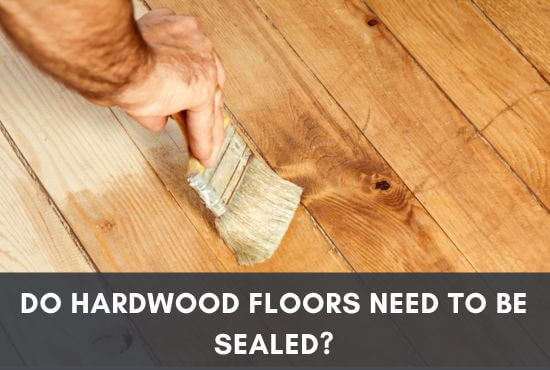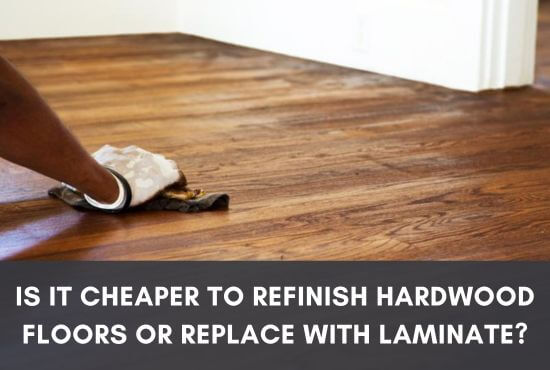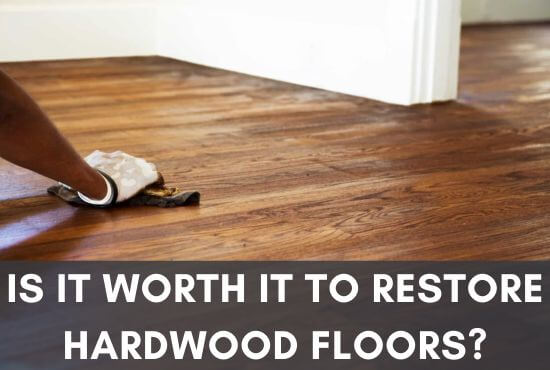Hardwood floors are often not recommended to be exposed to wear and tear factors.
Manufacturers and other hardwood flooring owners suggest getting a protective layer over the floors to protect them from wearing down or getting damaged.
A common way to provide this protective layer is through waxing. However, many wonder if it is suitable for hardwood floors or not.
If your hardwood floors are not engineered, you can wax them without worry. Waxing has a few disadvantages, which we will consider later on, but whether these cons matter to you is an entirely different scenario.
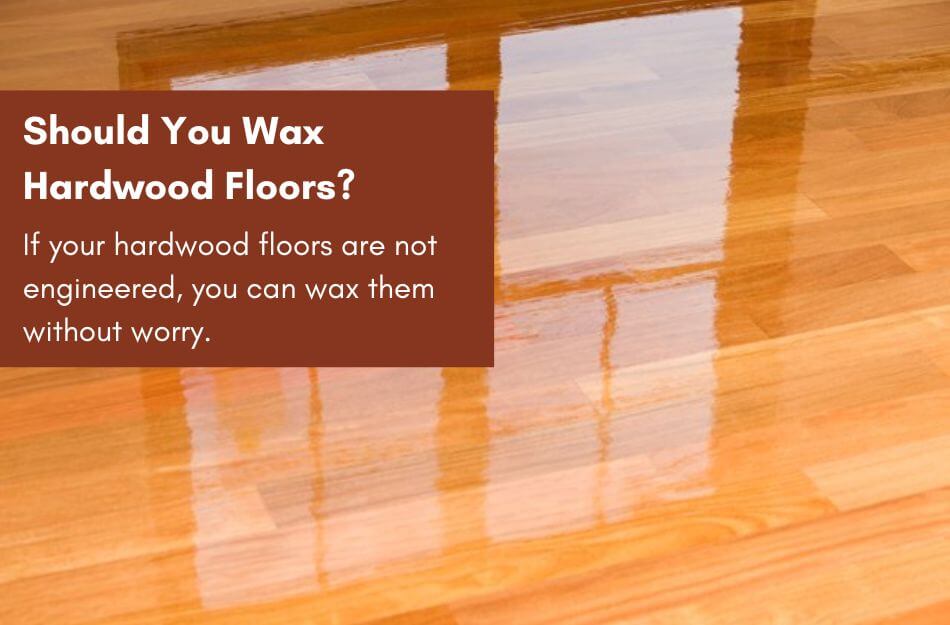
Let’s dive into the details of waxing hardwood floors!
Table of Contents
- 1 What Is A Wax?
- 2 On Which Surfaces Can You Use Floor Wax?
- 3 Does Waxing Damage Floors?
- 4 What Are The Advantages Of Wax On Wood?
- 5 What Are The Disadvantages Of Wax On Wood?
- 6 How Often Should You Wax Hardwood Floors?
- 7 How Much Time Does Wax Need To Dry?
- 8 The Best Wax For Hardwood Floors
- 9 Can I Use Car Wax On Hardwood Floors?
- 10 Do Wooden Floors Need Waxing?
- 11 How Do I Wax A Hardwood Floor?
- 12 What Is The Best Way To Clean A Waxed Wood Floor?
- 13 Does Waxing Hardwood Floor Make It Darker?
- 14 How Long Does Wax Last On Hardwood Floors?
- 15 Takeaway
What Is A Wax?
Waxes for hardwood floors were originally made from natural substances such as beeswax, carnauba wax, etc.
With the passage of time and industry advancements, these products were replaced by commercial synthetic products.
They gained popularity due to their ease of application, easy process, and faster results compared to the natural alternatives.
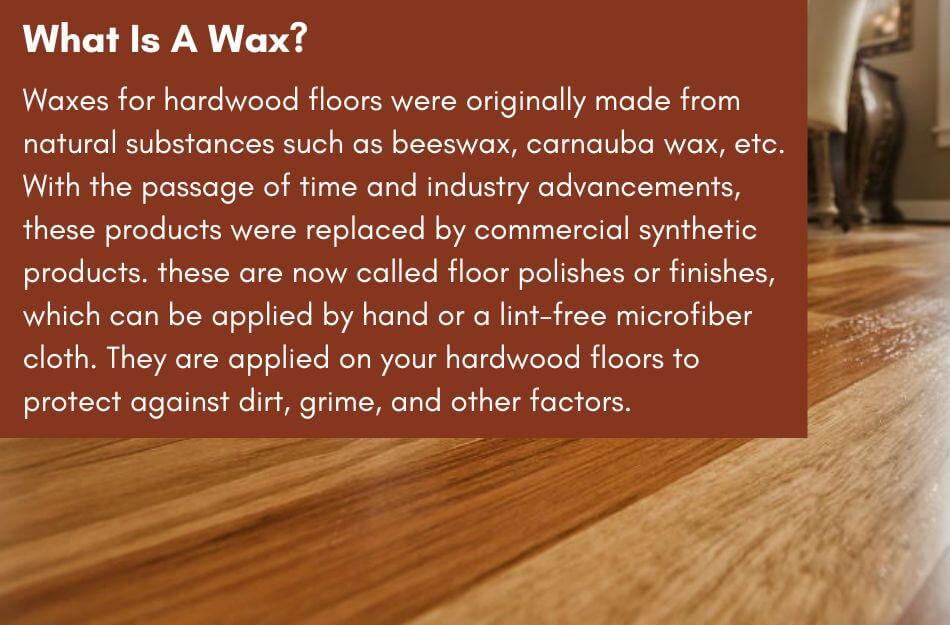
However, many flooring specialists still recommend that owners use natural products. In the present day, you can get floor wax in solid and liquid forms, so you can choose which is the most convenient for you.
Moreover, these are now called floor polishes or finishes, which can be applied by hand or a lint-free microfiber cloth.
They are applied on your hardwood floors to protect against dirt, grime, and other factors. However, many argue on the fact whether they provide the claimed amount of resistance or not.
Also Read: How To Clean And Deodorize Hardwood Floors? The Easy Guide
On Which Surfaces Can You Use Floor Wax?
Floor wax suits many surfaces, including unfinished wood, hardwood, and vinyl. These surfaces are the prime candidates for waxing as they can provide the exquisite treatment they direly need.
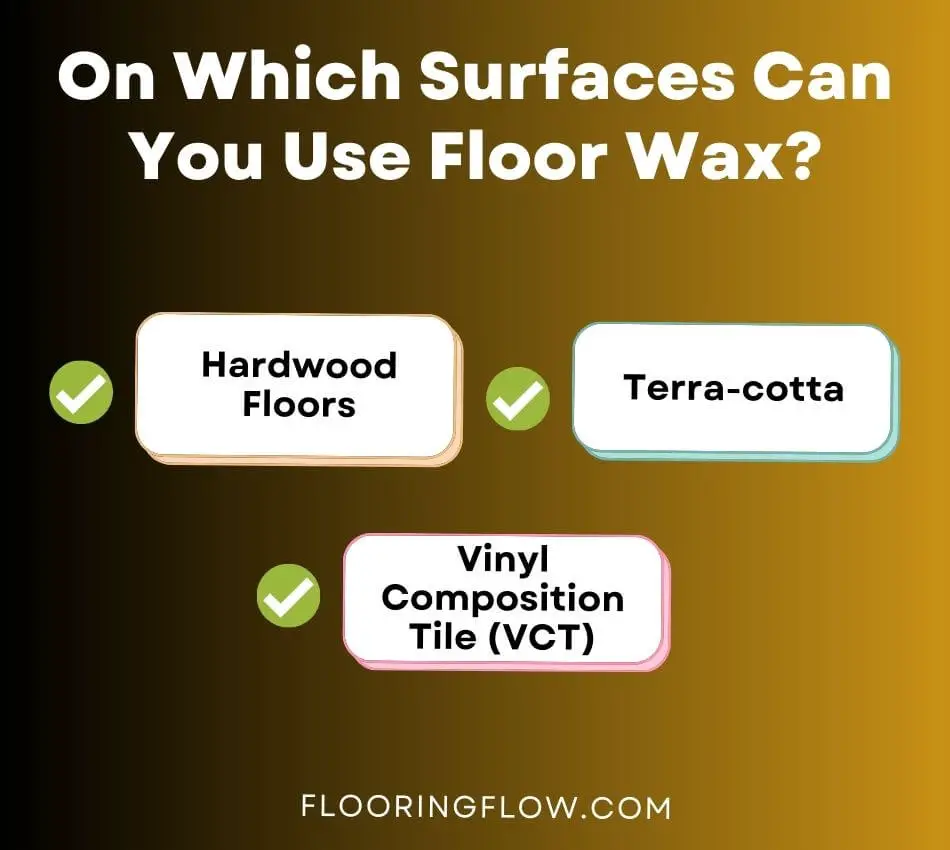
Hardwood Floors
Hardwood floors are one of the best ways to increase the style of your house and add a bold statement.
However, if you do not care for and maintain them well, they might turn dull and hazy over time. In the worst cases, they can even start to lose their color.
Hardwood floors do not come cheap, and after spending a decent amount of money, you would surely want the floors to retain their value and prove that they were the right decision.
Hence, you would be looking forward to increasing their longevity and finding ways to improve their condition.
An affordable option is waxing, which is very common and does not strain your budget.
Hardwood floors, including parquet, are the most suitable candidates for waxing as they are the most common flooring methods in houses and face a major wear and tear problem over time.
Moreover, it is an undeniable fact that hardwood floors need waxing.
It doesn’t matter if they are made from new, old, or recycled wood, or if they are brand new or a hundred years old, they all need timely waxing to protect their surfaces from the actions of constant use.
Floor wax allows the porous surface of the wood to be sealed so no moisture can reach the wood fibers and cause any damage.
Floor wax increases your hardwood floors’ lifespan and helps restore color. Only a few coats and buffing sessions can make dull, hazy hardwood floors look brand new.
Moreover, it provides them with suitable protection against humidity, dirt, grime, and regular spillages on the floor.
Frequency: Every 6-18 months, varying upon the amount of traffic and wear.
See Also: What Is The Cheapest Way To Clean Hardwood Floors?
Terra-cotta
Usually, unglazed floor tiles and terra-cotta are waxed as soon as they are installed in a house.
The major reason is that they are dull in color during manufacturing and need a polishing and buffing session to get their original shine.
Waxing or sealing them can bring out various types of finishes, such as matte or shiny, and produce color variations accordingly.
Furthermore, waxing protects them against stains and other factors that can spoil the tiles’ texture or color.
Waxing also helps in increasing the lifespan of these tiles and gives them a decent resistance level against minor scratches.
If not for waxing, these scratches would have been permanent and irreversible, damaging the appearance and classy look of the terra-cotta.
Furthermore, wax coats need to be replaced after some time as they wear off or get torn, depending on the wear and tear they must bear.
Frequency: Every 1-2 years, varying upon the amount of traffic and wear.
Vinyl Composition Tile (VCT)
Usually, vinyl tiles come with a factory finish, giving them a pre-defined shine and glossy appearance, nullifying the need to seal or wax further.
However, Vinyl Composition Tile requires waxing as it has no luxurious factory finishing.
Vinyl Composition Tile must be waxed or sealed when installed, mainly because the porous surface can quickly give in to humidity and other factors.
Besides, you can’t afford the risk of leaving it exposed and welcome possibilities of spillage and other damaging actions as they can completely destroy the vinyl surface.
Waxing can help protect the Vinyl Composition Tile and form a non-permeable layer on top which will disallow the type of substance from passing through and posing any threat to the structure’s health.
Therefore, waxing Vinyl Composition Tile is a superb idea that can lead to many benefits in the long term.
Frequency: Every 6-12 months, varying upon the amount of traffic and wear.
Does Waxing Damage Floors?
Waxing can damage various surfaces if you are not careful enough and seal the wrong surface.
Waxing is surely a great way to protect floors but if you do it on surfaces that aren’t meant to be waxed, you will be causing even more damage than benefit you intended to do.
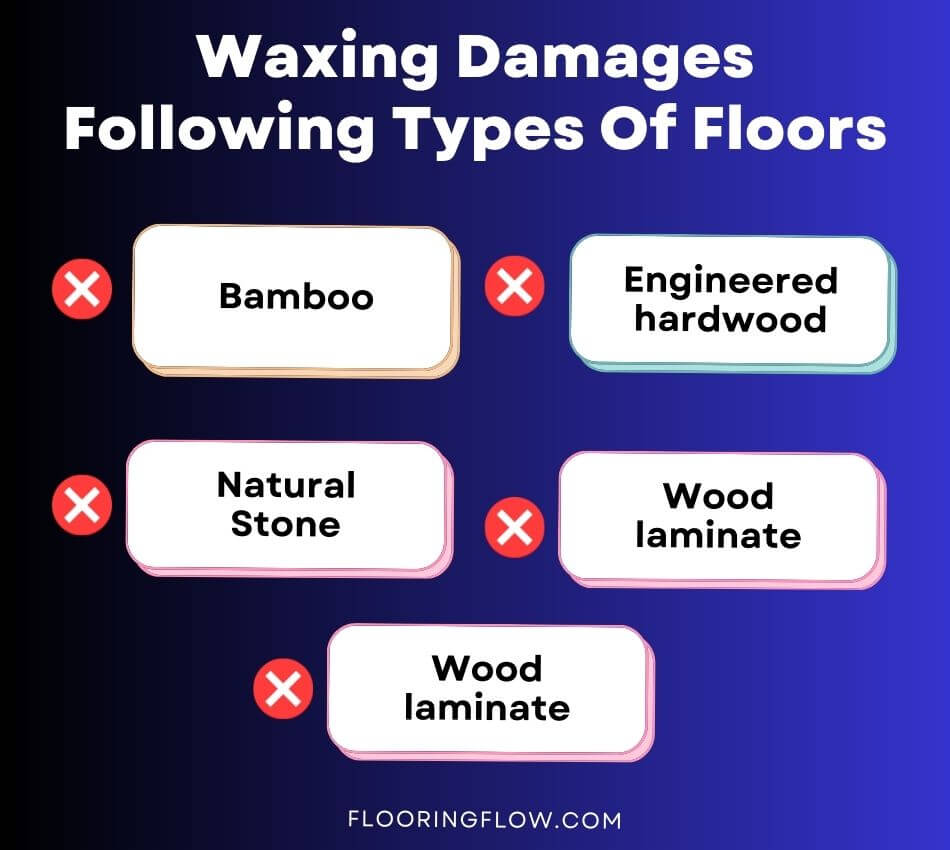
Engineered hardwood
Engineered hardwood is one of the finest hardwoods on the market. Its greatest feature is the composition of the material, which is a thin layer of hardwood bonded over plywood.
Moreover, the added benefit which provokes people to choose this option is the acrylic factory finish which saves them the cost of sealing or waxing.
Therefore, it is not only foolish but also dangerous if you wax engineered hardwood floors.
Not only do they become slippery, but as there is already a thin layer of sealant present, the wax will not get absorbed into the surface and will only cause more problems for you.
If left on for a longer period, it can even solidify on the top and darken the wood’s upper layer, causing it to lose color over time or become cloudy and hazy.
Hence, it is best to consult with the manufacturer’s instructions before getting your engineered hardwood floors waxed.
Wood laminate
Wood laminate looks like wood but isn’t a wooden surface. It is made from a particle board base attached to a photo-like layer and bonded to the surface.
They are super-impressive in appearance and can provide you with a refined wooden look without being made of wood at all.
Moreover, they are also pre-finished, so they don’t require further sealing or waxing. Hence, it is not suitable to wax these as they can’t absorb them, and they won’t have any benefit.
It is best that you only use cleaners to clean them and do not attempt any form of sealing.
Bamboo
Bamboo is also a natural substance used in floorings and gives a luscious look to your house.
However, many companies that manufacture bamboo floorings provide a finish to increase the shine and protect it from any unwanted substances and humidity. Hence, it is not suitable to wax these surfaces.
Natural Stone
Natural stone has a porous surface, but it isn’t suitable to wax it. Stones are pretty rugged and tough on their own, and with the kind of surface they have, waxing them will not bear any fruits.
In fact, it will either come off or must be removed after some time, as it can damage the rough and tough appearance of natural stones.
Furthermore, instead of making them shine, wax makes the stones even duller, which can be seriously concerning if you are particular about the appearance of the surface.
A luxury vinyl tile (LVT)
As the name suggests, this tile already has a luxurious and premium finish. The impermeable finish will not absorb wax; hence, waxing LVT will only cause more problems than benefits.
It can lead to dullness in the appearance of the tile; moreover, the wax can build up and cause slipperiness on the surface.
What Are The Advantages Of Wax On Wood?
Wax is gaining more popularity with every passing day due to the ease of application and other prominent features.
People are beginning to prefer it over polyurethane finishes which have been used for many decades for sealing hardwood floors.
An amazing factor about floor wax is that it gives a very low sheen, which makes the appearance more natural and relaxed.
Such an appearance is almost impossible to attain with a polyurethane finish.
Below are some of the most common and known advantages of using wax to protect your flooring surfaces:
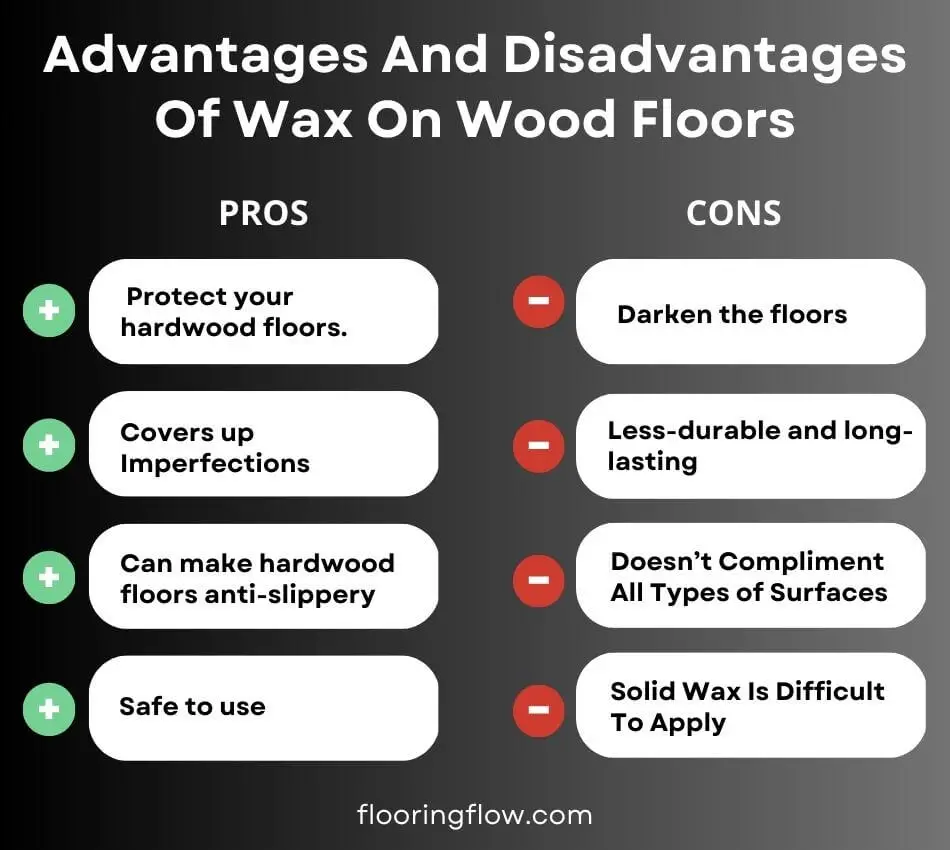
Health of Floors
Waxing floors regularly and doing so on time is one of the best ways to preserve and protect your hardwood floors.
If you have children or pets in the house, you might face the problem of spillages and urination on the floor.
Although you need to work on these factors and try to limit them, as you do so, you are risking the sovereignty of your hardwood floors if you leave them exposed.
Wax finishes can not only protect from spillage or urine, but they can also prevent any scratches caused by your pet’s nails.
Moreover, a wax finish can seep into the surface’s pores and settle in, giving your hardwood floors the best protection and keeping the wood fibers firm and strong.
Covers up Imperfections
Your wooden floor may have some damage in the form of dents or scratches. These can be visible from a distance and might ruin the overall look of your hardwood floors.
Such imperfections can be easily covered by wax finishes, forming a coat on the surface.
Moreover, as the wax finish is a bit shiny, it reflects light off the surface, making such dents and scratches less visible to the naked eye.
Anti-Slip
Whether the flooring is installed in your house or your office, you certainly wouldn’t want anyone to slip and fall on it.
Hardwood floors can be quite slippery, especially after they have been polished, and it becomes fairly hard to have a decent grip on them.
Waxing them, however, can solve this problem once and for all, as wax can provide you with the desired amount of grip that you are looking for.
Safe To Use
The biggest reason for you to prefer wax over any other type of sealing substance is the health-friendly nature of this product.
Not only does it keep your hardwood floors safe, but it also protects you from toxic substances which are usually found in such products.
Both liquid wax and solid paste wax have proven to be the healthiest options in this scenario as they contain the least amount of VOCs (volatile organic compounds) compared to competitive products and solutions.
If you want to provide your family member with a safer environment to move in, wax finishes are your go-to option.
Simple application
Alternatives of wax are not just costly but also very difficult to apply. You only need a sponge mop for liquid waxes and a lint-free microfiber cloth for solid waxes, and you can get started.
Moreover, the buffing process is also very easy, as you can either rent an electric buffer or use a cloth to buff the entire floor. Therefore, it is cheap but fairly simple and straightforward to use.
Smell
A floor finish having a terrible odor can be impossible to bear. It can be hard to even stand in a room full of pungent smells, and it can be some time before you allow ventilation in the room and the smell fades away.
However, you won’t need to face this problem with waxes as they have less offensive odors than polyurethane and acid-cured finishes.
Therefore, if you have a sensitive nose and can’t bear strong smells, wax finishes have you covered.
What Are The Disadvantages Of Wax On Wood?
Everything has its pros and cons, and so do waxes. Despite having numerous prominent benefits, they also have disadvantages for many people.
While some still do not consider them as significant cons, it is our responsibility to give you a clear picture.
Staining
The most disturbing disadvantage of wax finishing is its attribute to stain the wood over time and cause it to darken or lose color.
Although timely re-waxing can be avoided, it is still a major concern for many people. You can also avoid this problem by using wax with a combination of another sealant, such as shellac.
You can use the other sealant as the base coat and wax it from the top; this might even increase the longevity of your flooring seal.
Durability
Although it is very cost-effective and easy to apply, it is less durable and long-lasting than many competitors, such as polyurethane.
This means that although you get a pretty strong protective shield for some time, it might last less than expected.
After some time, you will surely need to replace it with new coatings and repeat the entire process.
Doesn’t Compliment All Types of Surfaces
Despite the fact that wax is increasing in popularity and acceptance each day, and solid wax can give you stunning results even after a few coats, you still can’t use them on all surfaces.
No wax surfaces do not support any wax and will only be damaged by it; hence, wax is not compatible with all surfaces.
Moreover, you can’t use wax on surfaces treated or sealed by urethane or polyurethane.
These two categories don’t go hand in hand; if you try to mix them up, you’ll ruin your hardwood floors.
The same goes for liquid wax, which should not be used on surfaces with urethane or unfinished surfaces as it will not yield any benefit.
Solid Wax Is Difficult To Apply
Solid paste wax, although giving superb results, costs you much effort and burns way too many calories for such a job.
The job is manual, and you must rub a cloth on the surface to apply and buff it later. Although liquid wax is easier to apply, solid paste wax will keep you on your toes and will make you tired.
However, there is a cheeky way to make this application process easier. All you need is an old cotton T-shirt and some water.
You need to dampen the shirt and wring it out properly. Then, apply the paste wax and apply it on the floor.
The damp shirt will make the surface moist and make the wax softer to decrease friction and allow you to apply it faster with much less effort.
How Often Should You Wax Hardwood Floors?
A general rule of thumb is to get new waxing for your wooden floors after 1 year.
However, The wear and tear on the hardwood floors will decide the time after which you must re-wax your hardwood floors.
Besides, if you are only a few members in a house and the waxed floor is only a single room, you may not need to reapply the coats for 2-3 years.
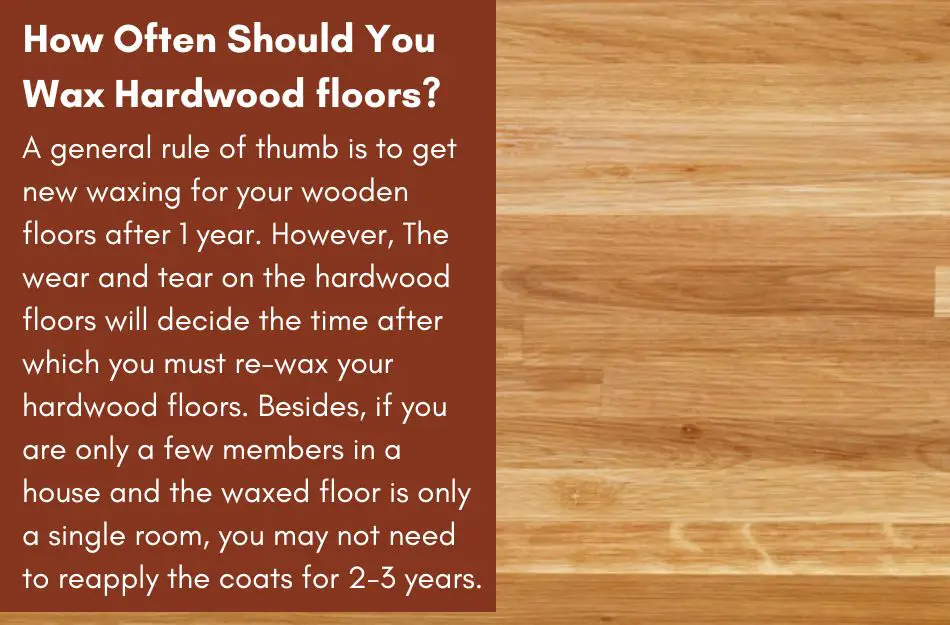
But if you’ve waxed the flooring in a commercial building, you might need to get the process redone after even a month or two.
Furthermore, it is optional to get as many coats as you had the first time you waxed your floor.
But you can add another coat on the floor if the total number of coats your hardwood floor receives is under 6 (for liquid waxes) and 4 (for solid paste waxes).
Moreover, once you’ve reached this number, it is possible that you might not need another coat.
If the wax coat looks weary, try giving it a buff, and if the coat is good underneath, you will be just fine, and a fresh appearance will replace the old worn-out look.
However, if it doesn’t work, you would need to get rid of all the previous coatings and clean the floor thoroughly.
Go either for a power wish or use a commercial cleaner that supports your wood type. Once you finish the process, you can reen the wax coats and buff them out.
How Much Time Does Wax Need To Dry?
On average, solid wax takes at least 6 to 8 hours to dry, whereas liquid wax can take up to 4 hours, depending on the atmosphere, ventilation, and exposure to sunlight.
However, it is preferred not to step on it until at least 72 hours, as you might get the wax stuck on your shoes.
The Best Wax For Hardwood Floors
Hardwood floors are a luxury that many can’t even afford. They are nowhere cheap and often succumb to factors of wear and tear.
It won’t be wrong to label them as fragile luxuries. Hence, waxing them and giving them a protective coat is important to retain their value and maintain their superb appearance.
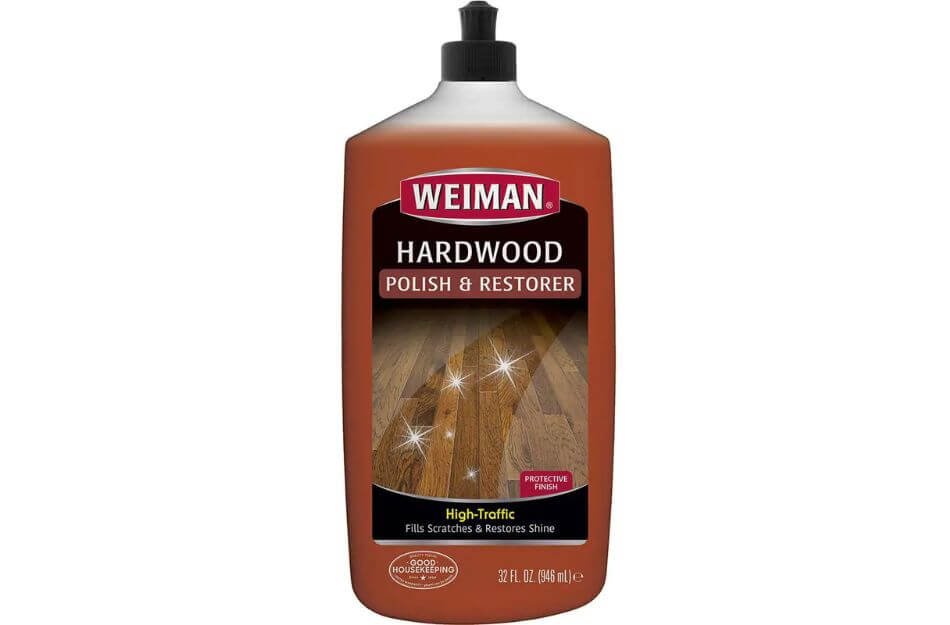
There are basically two types of wax:
- Liquid wax
- Solid paste wax
Liquid wax is usually thinner and easier to apply, but it needs more coats to achieve the same level of protection and strength as solid paste wax.
Paste wax is very durable and needs only a few coatings, but it is very hard to apply.
If you use a quality wax, it will protect the hardwood floors from external factors and feed them internally as they have conditioning elements that keep the wood fibers in perfect health, increase their longevity, and improve their strength.
Commercial floor waxes contain many ingredients, and petroleum is one of them.
If you are a nature lover and want to use natural products, you can use beeswax or linseed oil, which also serves the same purpose but won’t be as effective as a synthetic product.
However, you must stay vigilant to not use vinyl or linoleum floor wax on any wooden surface. These contain harmful chemicals which can severely damage your hardwood floors.
Can I Use Car Wax On Hardwood Floors?
Car wax can be used on wooden floorings; however, it is not recommended. Many people confuse floor wax with candle wax or car wax.
But in reality, all three of these products are different from each other.
Despite the fact that car wax is a versatile product and is used for many purposes, even inside the house, you must not use it for flooring.
Many people use car waxes for various purposes, such as preventing fog on bathroom mirrors, giving shine to bathroom tiles, preventing ice from sticking to shovels, and putting a halt to molds and mildews on showers, but using it for flooring is fairly not a wise idea.
Car wax is not designed to deal with the type of wear and tear that floor wax faces. Hence, it is less durable than specific floor waxes.
Even though you can apply a few extra coats to increase its resistance against traffic, you would only be wasting product and risking wax buildup on your hardwood floors as it does not bear the load you expect.
Furthermore, car wax has never been tested or claimed to be effective by manufacturers for any such activity, and you would simply be going against their word.
Therefore, in case of any damage to your hardwood floors, you cannot sue the manufacturer or hold the product responsible.
Hardwood floors are very expensive, and it is not recommended to meddle with random products and test them on these floors. Hence, using only floor wax to protect and seal your hardwood floors is best.
Do Wooden Floors Need Waxing?

Most wooden floors made commercially do not need waxing or sealing. They have a factory-provided finish which makes them shine and protects their luster.
However, other types of wooden floorings, such as regular hardwood flooring, require waxing as it is not precoated with substances such as polyurethane and hence should be waxed.
Moreover, not only do they require waxing once, but once these surfaces become worn, they should be recoated to refresh the layer of protection that they had.
Furthermore, natural wood is yet another type of flooring material that is usually untreated and does not have any protective coat.
To sustain its natural beauty and protect it from the damages caused by wear and tear, heavy traffic, and actions of weather; you must coat it with floor wax.
Besides, it is also suitable to apply over varnished wood. However, it would be best to ensure the floor is sanded down first, as uneven fibers and textures would not let the wax settle in.
Hence, it would be best only to attempt sealing or waxing once the floor has been sanded down.
How Do I Wax A Hardwood Floor?
Applying wax is a fairly simple task as all you have to do is apply the wax to the floor by hand and rub it until it is absorbed; then, you must wait for it to dry before you can buff it.
However, it is important to ensure that the surface is clear of any traffic or storage; hence, you must remove all the people, objects, and furniture from the hardwood floors.
Moreover, it is important to check all the safety factors before dealing with wax, and you must wear gloves, masks, and eyeglasses to protect yourself from any possible damage.
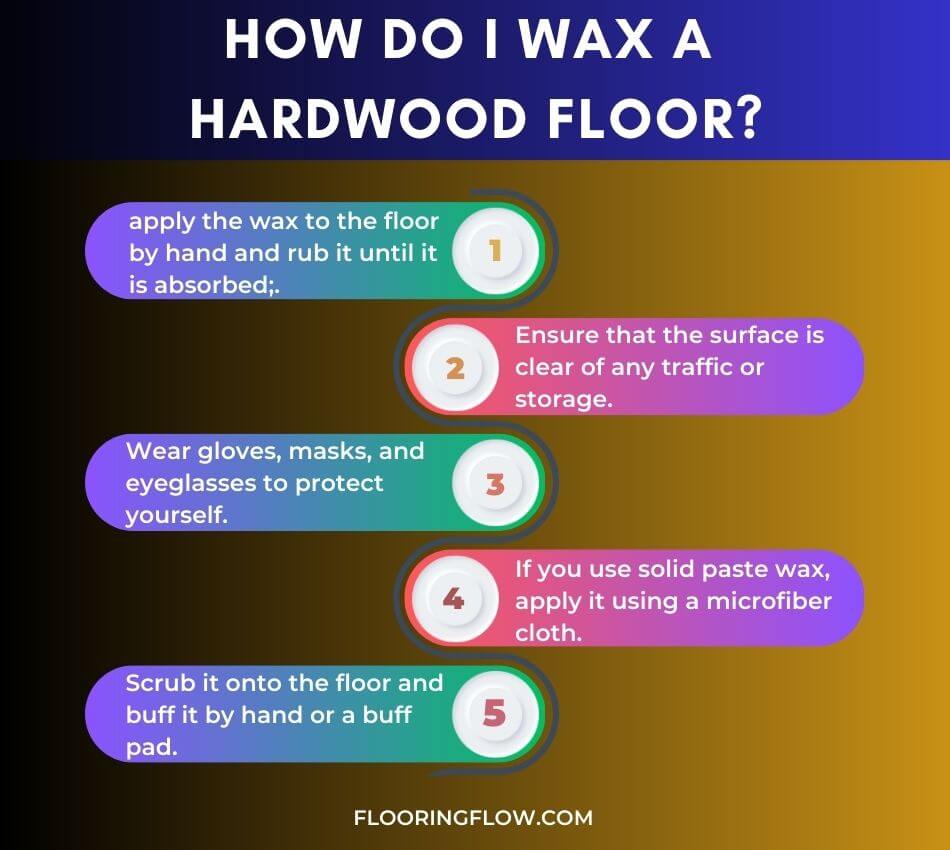
If you use solid paste wax, apply it using a microfiber cloth and use a putty knife to take it out.
All you have to do is scrub it onto the floor, and once you’ve covered the entire floor, you can buff it either by hand or by using a buff pad.
You can apply liquid wax by hand as it is much easier. Pour on the surface and scrub it on the floor with a cloth or a sponge mop.
Once you are done, you can repeat the buffing process and ensure that all the area is buffed properly.
What Is The Best Way To Clean A Waxed Wood Floor?
The best way to clean a waxed hardwood floor is by dry-mopping regularly and only using a damp cloth when necessary.
If you want the waxing to last for some time and your hardwood floors to look as shiny as they are, you must keep the floors clean.
Dust and dirt can accumulate on the surface, and the shiny look of the wax floor will only accentuate the dirt, making it look more prominent.
Hence, it is important to clean the floors timely. However, wet mopping is the greatest enemy for waxed floors, and excessive water or moisture can damage wax layers.
It is best to use a dry mop and clean the floor regularly to immediately catch any dust or dirt.
Moreover, if need be, you can dampen a cloth and use it to pick up any remnants of spillage or other such occurrences.
Regular vacuuming can also help ensure the cleanliness of your waxed hardwood floors and that they are maintained in their best condition.
In addition, avoid excessive cleaning as it can remove or damage the wax finish, and if you have to clean it too often, make sure to recoat the surface once in a while to maintain the shiny and protective layer.
Another important factor is that regular cleaners should not be used on waxed surfaces as they might contain substances that can corrode the wax layer.
Hence, it is important to read the instructions and check whether they are wax-friendly. If you can’t find a suitable product on the market, you can always make an effective cleaner at home.
Does Waxing Hardwood Floor Make It Darker?
Extensive wax coatings can make your hardwood floors darker over time.
If you have been adding coats to your wax finish for some time now, there is a high possibility that the hardwood floor is going to get darker and lose its original color and grain.
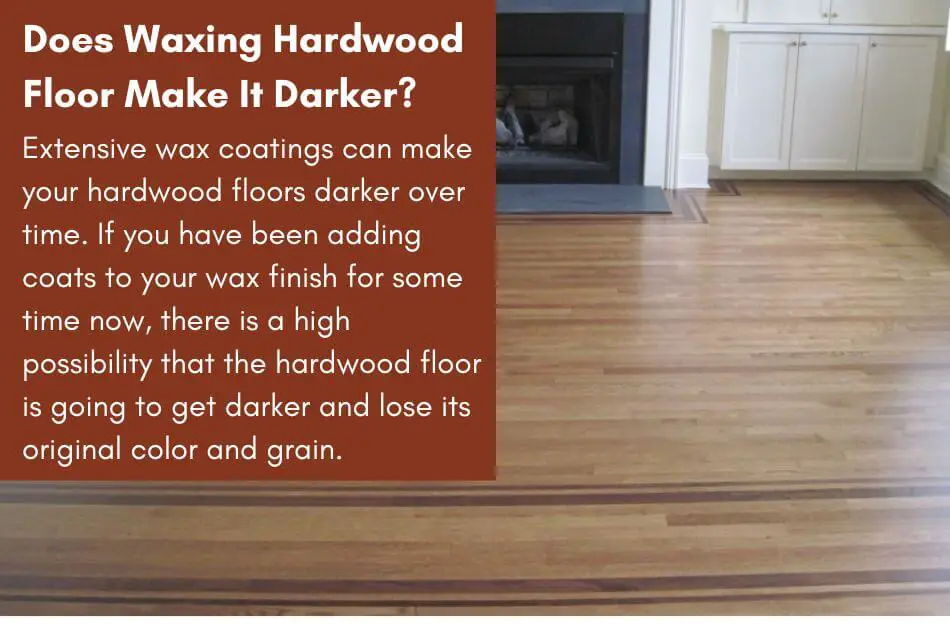
Moreover, as the number of coatings increases on your hardwood floors, it causes wax buildup, leading to suffocation of the wooden floor due to which humidity might get trapped inside.
Over time, this can cause your hardwood floors to darken as dirt and grim will get stuck on the surface.
How Long Does Wax Last On Hardwood Floors?
Usually, waxes last almost 6 months to 2-3 years depending on various factors. Liquid and solid waxes have different lifespans and there are some other factors too that affect this number.
Type of Wax
The type of wax used matters a lot in deciding or determining the lifespan of your wax coatings. Firstly, solid-paste waxes last the longest.
Despite requiring only a few coats, they can get very hard and resistant to scratches and factors of wear and tear.
Their strength and durability are unmatched and if you use a good quality solid wax, you might expect it to last for almost 3 years before you need to change it.
Secondly, liquid waxes are much thinner and low in viscosity; hence, they require a greater number of coats and still, they can’t meet the same level of hardness or durability as solid waxes.
They are more prone to wear and tear and can usually give in to scratches and scuff marks.
They usually last somewhere around 6 months to 1 year depending on product quality and usage.
Lastly, we have silicone-based waxes which offer better resistance compared to regular liquid waxes. They are thicker and higher in viscosity, and can hence, provide better durability.
They usually last 1 to 1.5 years depending on how intense your use is and the quality of the product.
Traffic
The amount of traffic your hardwood floors receive matters a lot in determining how much time your wax coatings would last before needing any replacement.
Usually, domestic hardwood floors do not receive as much traffic as commercial ones.
Furthermore, there are areas in the house that receive less traffic than others; for instance, a TV lounge compared to a bedroom, and the same goes for commercials.
An increase in traffic would mean your wax coatings are getting worn out quickly while a decrease in traffic can increase the amount of time the coatings may last.
You can keep a simple rule in mind; low traffic will add 6 months to your wax coating’s life whereas an increase will deduct 6 months from the same time frame.
Quality
Another factor that affects the lifespan of your wax coatings is the quality of the product. It matters a lot because a low-quality product will give you less durability than a high-quality product.
For instance, a high-quality solid-paste wax with medium traffic can last up to 3 years, whereas a low-quality product with the same specifications will hardly give you merely 1.5-2 years before it wears out and needs replacement.
Hence, whether you are using solid, liquid, or silicon-based wax, it is important that you select the right product and make sure that the quality is tested and proven.
Moreover, taking care of your wax finishes is crucial, as extensive wear and tear can cause them to deteriorate quickly.
Therefore, it is important to take proper care of them to ensure longevity and prolonged health of the wax coatings and your hardwood floors.
Takeaway
Hardwood floors should be waxed to ensure their safety and protection against various deteriorating factors and make them look more appealing.
However, knowing whether your hardwood floors are engineered or contain a pre-finished layer unsuitable for wax is crucial.
Overall, waxing is a decent option to increase the longevity of your hardwood flooring and make it look more luscious and attractive almost immediately.

As a co-creator of FlooringFlow.com, Emma Sophia comes on board to answer all your questions related to any flooring problems. Together with John Henry, she’s gained extensive experience in fixing many flooring problems in their own house as well as in friends and family’s. Now, she wants to share her knowledge that she gained during floor remodeling, restoring, and DIY projects.


